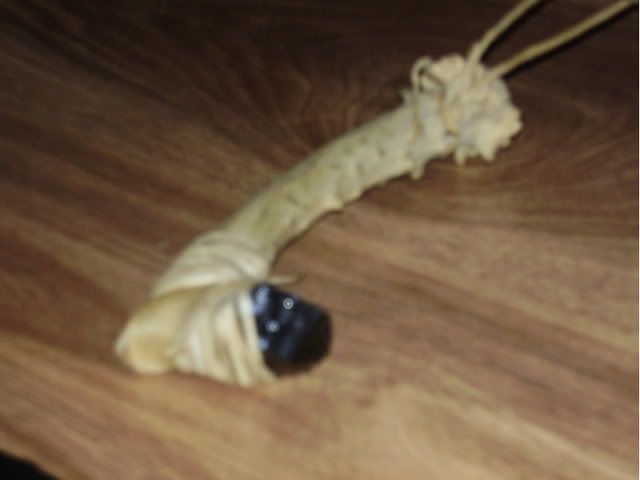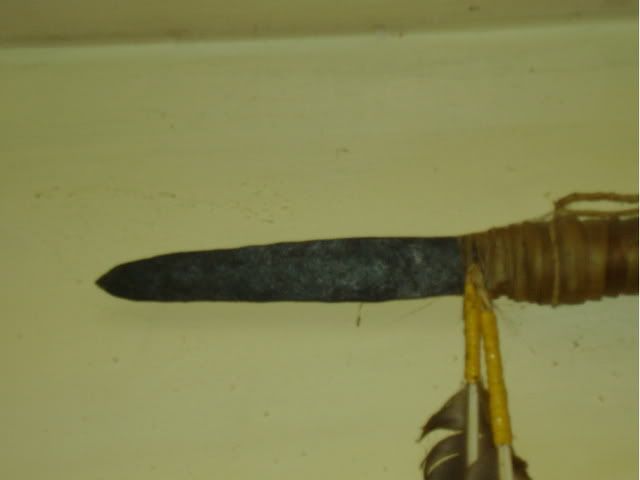-
Friends, our 2nd Amendment rights are always under attack and the NRA has been a constant for decades in helping fight that fight.
We have partnered with the NRA to offer you a discount on membership and Muzzleloading Forum gets a small percentage too of each membership, so you are supporting both the NRA and us.
Use this link to sign up please; https://membership.nra.org/recruiters/join/XR045103
You are using an out of date browser. It may not display this or other websites correctly.
You should upgrade or use an alternative browser.
You should upgrade or use an alternative browser.
Trap spring knife
- Thread starter tryinhard
- Start date

Help Support Muzzleloading Forum:
This site may earn a commission from merchant affiliate
links, including eBay, Amazon, and others.
- Status
- Not open for further replies.
I have not seen any period references to them, i used to make them to use in the construction of replica NA artifacts, I also used them for lance points, it is quite a chore to heat over a fire and pound into shape with rocks, which is how I speculated the very early NA items were made from found or stolen traps.
grettadarlean
32 Cal.
- Joined
- Aug 21, 2005
- Messages
- 11
- Reaction score
- 0

BOB WERE YOU TRYING TO POST A PHOTO LIKE THIS?
Not trail made perhaps, but most forts/posts had smiths and knives and hawks built by them can be documented - there are existing examples of such smith made knives.Knives were such a big part of fur trade inventories that trail made knives just didn't make sense.
Also depends on time and place - here in the SW a good portion of the knives used were locally made since trade had been heavily restricted by Spain and continued to be for quite a while even after self rule was instituted in the 1820's.
I surmised that early on the tribes that were not prone to trade might tend to steal whatever they could, the trap springs, barrel hoops and other illgotten items could have been put to many uses, and the springs do make good hide scrapers.This is a scraper made with an obsidian "blade" a piece of trap steel or any other piece of metal could be fitted to the handle.


Trap spring knives are more fantasy than fact. Very very few originals exist, and even those tend to be from later time periods - well into the 1800's, and then usually late 1800's.
The key "feature" on them is that ring/loop on the end. That identifies it as from a trap spring. Without that ring/loop, it could have been made from any piece of steel.
And the whole issue quickly gets ... tainted ... by modern fantasy/ninja fighting knives with that ring/loop on the end of the handle - so they can be "twirled" around your finger in a fight to show how "great" you are. Fantasy.
So once that loop is removed, that knife could have been made from any piece of steel. Plus most broken trap springs broke in the bend. The two parts then were easily converted to a hide scraper with minimal tools. Just grind on a rock to true up the end and sharpen it.
Trap spring knives do look nice and cool. But have little documentable history behind them. Plus a knife of any length really does require that you re-forge the whole spring. Half just ends up too short for a blade and handle.
Just my humble thoughts to share, and best used in conjunction with your own research.
Mikey - that grumpy ol' German blacksmith out in the Hinterlands
The key "feature" on them is that ring/loop on the end. That identifies it as from a trap spring. Without that ring/loop, it could have been made from any piece of steel.
And the whole issue quickly gets ... tainted ... by modern fantasy/ninja fighting knives with that ring/loop on the end of the handle - so they can be "twirled" around your finger in a fight to show how "great" you are. Fantasy.
So once that loop is removed, that knife could have been made from any piece of steel. Plus most broken trap springs broke in the bend. The two parts then were easily converted to a hide scraper with minimal tools. Just grind on a rock to true up the end and sharpen it.
Trap spring knives do look nice and cool. But have little documentable history behind them. Plus a knife of any length really does require that you re-forge the whole spring. Half just ends up too short for a blade and handle.
Just my humble thoughts to share, and best used in conjunction with your own research.
Mikey - that grumpy ol' German blacksmith out in the Hinterlands
Another point, what price was listed for a trap spring? What about the common scalping knife? I'm working from memory but I think the spring cost more. In any event why would anyone bother to make a knife from a trap spring? Sometimes the springs broke or were too soft so scrap spring material was probably available and if some have found documented knives, well that's that. Still, I think the amount of such knives may have been rare. Pichou is more likely correct. I can't recall hide scrapers being a fur trade item and a steel scraper would have been better than bone/antler. I can't recall crooked knives on some of the lists so maybe a crook knife from a trap spring. Just some thoughts.
I have used them for making lance points on NA replica lances,the loops are removed and the spring can be roughly shaped when hot and lashed to the shaft of the lance same as a stone point would have been, this is the type of usage I think the NA's might have found for traps that they stole or found.the work can be done with stones but some simple iron/steel tools would make it quicker and cleaner but I would not venture to say how many NA's had access to smiths tools.


All points being taken, here's mine. The fact that only a "few" examples of original trapspring knives do exist doesn't mean that is all there was. It is my belief that they came to be because of emergency situations, in the case of the white trapper such as having your gear lost or stolen and retrieving one of your, or someone else's sets and creating a life saving tool. Or, in the case of the indigenous aboriginal humanoids existing in the area, a trap became an excellent source of raw material with which to fashion a tool or weapon. And, as with all things of iron, steel or wood, nature takes it's toll. Rust, rot and loss take place and the evidence is destroyed. This also has happened to many other items carried into the wilderness during the early to mid eighteen hundreds by the thousands of trappers who ventured there. The "experts" may disagree, but most of them (experts) I have run across have earned their credentials through attendence at the University of Self Certification, so I take what they say with a pinch of salt. There are very few absolutes in historical justification, mostly opinions, educated or otherwise. this is the case with knives fashioned from trapsprings.
All that being said, they sure make a neat and useful knife.
 [/img]
[/img]
All that being said, they sure make a neat and useful knife.

Actually it's fairly simple. Heat to non-magnetic or slightly above and immerse with cutting edge down from the point to the back of the edge. Hold in the quenchant until the action ( sizzling, smoke, and sometimes fire) subsides. Gloves are recommended. Remove from the oil and hang to cool down. This gives a very hard edge with a still softened spine. This method works very well on trapsprings and steel from harrow and disc blades, but since this is all I work with, I don't know what the results would be with other steels.
T C Albert wrote an article on how he makes a trap spring dagger/knife in the Jan/Feb 2008 issue of Muzzleloader Magazine. Good info and lots of step-by-step pictures. Check it out if you get a chance.
Mikey - that grumpy ol' German blacksmith out in the Hinterlands
Mikey - that grumpy ol' German blacksmith out in the Hinterlands
- Status
- Not open for further replies.
Similar threads
Latest posts
-
2024/2025 Squirrel Hunting Thread...........
- Latest: Gum Slough Muzzleloader
-
I forgot to pack the roundballs - but the substitute worked
- Latest: Antelope Pete
-
-
-
-
-
-
-
-




